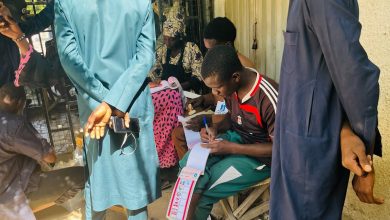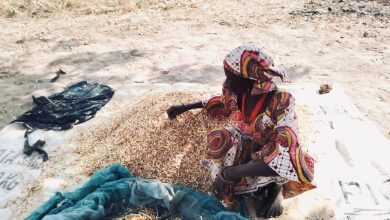GIS Data Reveals 31 IDP Camps At Risk Of Flooding In Northeast Nigeria
According to data analysed by HumAngle, several IDP camps in Maiduguri, Borno state, are at risk of flooding with property losses incurred if authorities do not act swiftly to protect lives and properties.

Changing climates are having serious environmental impacts across different parts of the world, and Maiduguri in Borno State, Northeast Nigeria, is not exempted from this.
Currently faced with a 12-year-old insurgency with its ever-changing dynamics, resource access has become far more limited in the state capital than ever before.
The insurgency, which has displaced millions of people, has also put them at risk of the impact of changing environments. Aside from not being able to access more resources, residents in different Internally Displaced Persons (IDP) camps are also at the mercy of government authorities who often falter in their responsibilities. At the base of this helplessness is the possibility of flooding that threatens to push displaced persons out of their camps.
Aside from the impact of climate change, massive displacements in other towns, leading to forced migration to Maiduguri, have also affected the geography of the city, causing it to lose surface soil.
A study by the University of Maiduguri glossed on the connection between the city’s vulnerability to flooding with urbanisation and associated environmental negligence, stating that “this urbanisation has generally induced flash floods, solid waste, distorted land use and environmental pollution.” It also noted that “the floods were largely due to excess solid waste generated and encroachment of large development into natural drainage channels in the metropolis.”
Almost 31 IDP camps at risk
In April 2021, Relief Web, a humanitarian information website, published a report which highlighted the cases of flash floods in Borno, putting at least 800 IDP households in jeopardy. Borno, because of its placement on a higher latitude in the country, is often overlooked as a flooding concern.
In the 2021 flood outlook prepared by the Nigeria Hydrological Services Agency (NIHSA), the state is not listed in the 27 highly probable flood risk states, with no indication of the likelihood of flash floods. Data analysed by HumAngle has revealed that this is not true.
Information extracted from Geohazard Risk Mapping Initiative in May 2021 has shown that there is a risk of flood affecting about 31 IDP camps in Maiduguri.
Interactive flood map of Maiduguri
Maiduguri is about 167 km² in size. The total area under assessment for flood risk is about 209.27 km² wide in a landmass area encompassing the Maiduguri metropolis and the areas surrounding the town. About 193km² of this total landmass is vulnerable to flood at different levels; 88.3km² of the total landmass is considered a high-risk area. And over 9,500 IDPs are vulnerable to flooding in these high-risk places. An estimated 17,153 IDPs might be susceptible to the hazard despite living in low-risk areas.
The flood risk analysis also shows that about 52.17 km² of the landmass within the Maiduguri area is considered to have low vulnerability to flood, 76.79 km² of the area falls under vulnerable, while about 11.46 km² is highly vulnerable.
This 250km streamflow model shows the direction in which the flood will pass through, thereby affecting some of the IDP camps. This is based on the natural slope configuration of the town.
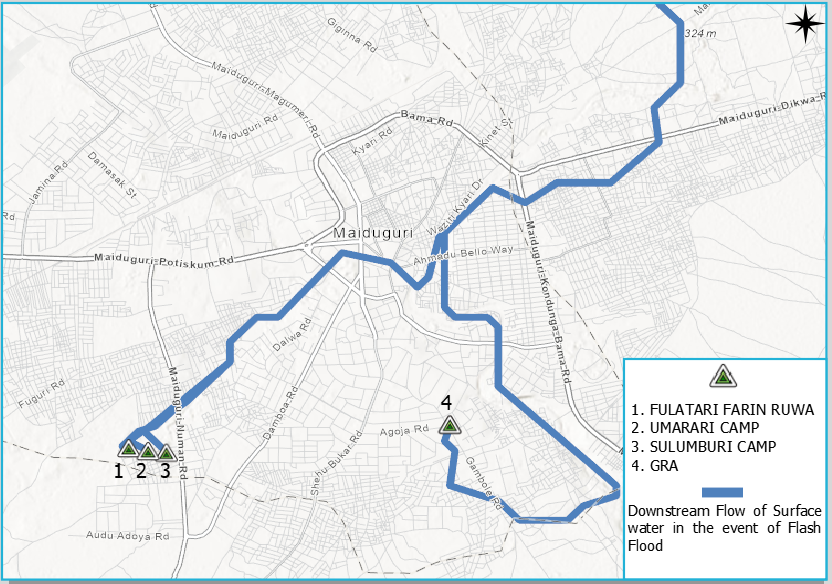
The surface water flow path is in line with the natural slope path of the city which begins from the bank of Lake Chad at the extreme northeastern end of Borno. In this flood vulnerability analysis, the surface run-off of the flow of water into the IDP camps shows that when intense rains start — and it will — the likelihood of flash flooding then becomes increased after each downpour.
Growing Population Increasing Vulnerability
A five-year analysis of some of the IDP camps and places around Maiduguri shows growth in physical structures, even around IDP camps. These growths put a strain on the topography of the various areas where the IDP camps are situated, making them more vulnerable during flooding.

In some of the reviewed locations, the soil area has become more shallow and human structures are slowly replacing natural breakers like trees, which can act as support systems during and against some of these disasters.
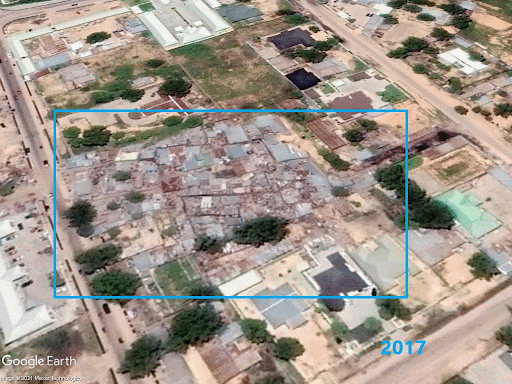
The compact nature of some of these structures — built very close to one another — increases their vulnerability. The trajectory of many of these areas over a five-year period also makes it obvious that the structures have not been spaced out but have been built very closely.
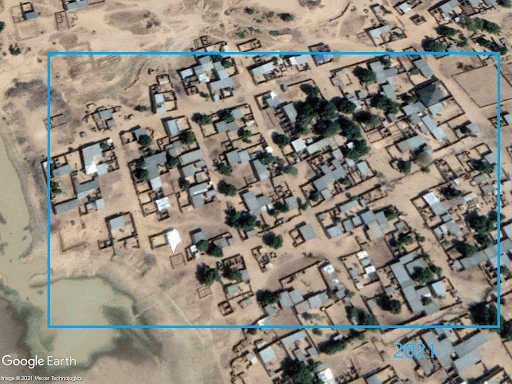
Despite these assessments, there is little to no effort on the part of the government to either avert these disasters, to make evacuation plans for them, or to prepare the IDPs in case of such emergencies.
Authorities Ghost Responsibilities
The National Emergency Management Agency (NEMA) was established to manage disasters in Nigeria. NEMA is mandated to tackle disaster-related issues through the establishment of concrete structures and measures. Such measures as the education of the public to raise their level of awareness and reduce the effects of disasters in the country. To allow effective response and coordination of efforts, several states in Nigeria operate a S-EMA.
When HumAngle reached out to Yabawa Kolo, Director-General of Borno State SEMA, she said she is “currently on medical leave” and gave the contact of someone acting in her stead. The acting person, simply called Gadau, when informed about the impending danger, said “you mean IDP camps are flooded with rainwater?”
HumAngle clarified that the camps are currently not flooded but are at risk of flooding, and he responded that “even last time about two weeks ago, we got a report about a camp in a particular village … We went there and saw that some of the camps were inside the water.”
“On our own part, we initiated a programme of meeting with partners who we are partnering with, in the fields of humanitarian activities and we have reached a certain kind of tentative agreement that we and the partners will partner in providing some sort of relief to the IDPs and at the same time, we have initiated at our own end that the areas which the rainwater flows through have been blocked, so we are making frantic efforts to see that this does not happen again,” he added.
HumAngle, however, soon discovered that Gadau was making reference to a flooding incident that has already happened, while the focus is on imminent ones. Upon correction, Gadau noted that “we have the mandate of talking to the people and rendering them our services in all these directions, not just the IDP camps but every part of Borno State. Now you are talking about IDP camps, we have done our best to ensure that these IDP camps are not flooded.”
He omitted plans that SEMA was actively taking to help the IDPs.
Attempts to reach the Nigeria Meteorological Agency (NIMET) to know if it shared relevant forecasts with the emergency management agencies were met with futility as HumAngle correspondents were directed to different persons who did not have information.
Meanwhile, the threat remains imminent. Kayode Adeniyi, a GIS expert, told HumAngle that “international NGOs validate aids required by each camp based on data derived from field officers and satellite imageries.”
“Further displacement due to flooding will make effective monitoring and validation difficult,” he explained. “They’ll have to start again and it will lead to delayed responses. In fact, most IDP camps use canopies; floods can move buildings so there is little guarantee for them.”
Support Our Journalism
There are millions of ordinary people affected by conflict in Africa whose stories are missing in the mainstream media. HumAngle is determined to tell those challenging and under-reported stories, hoping that the people impacted by these conflicts will find the safety and security they deserve.
To ensure that we continue to provide public service coverage, we have a small favour to ask you. We want you to be part of our journalistic endeavour by contributing a token to us.
Your donation will further promote a robust, free, and independent media.
Donate HereStay Closer To The Stories That Matter



